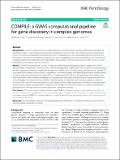| dc.contributor.author | Hill, Matthew J. | |
| dc.contributor.author | Penning, Bryan W. | |
| dc.contributor.author | McCann, Maureen C. | |
| dc.contributor.author | Carpita, Nicholas C. | |
| dc.date.accessioned | 2022-07-11T14:21:48Z | |
| dc.date.available | 2022-07-11T14:21:48Z | |
| dc.date.issued | 2022-07-02 | |
| dc.identifier.uri | https://hdl.handle.net/1721.1/143632 | |
| dc.description.abstract | Abstract
Background
Genome-Wide Association Studies (GWAS) are used to identify genes and alleles that contribute to quantitative traits in large and genetically diverse populations. However, traits with complex genetic architectures create an enormous computational load for discovery of candidate genes with acceptable statistical certainty. We developed a streamlined computational pipeline for GWAS (COMPILE) to accelerate identification and annotation of candidate maize genes associated with a quantitative trait, and then matches maize genes to their closest rice and Arabidopsis homologs by sequence similarity.
Results
COMPILE executed GWAS using a Mixed Linear Model that incorporated, without compression, recent advancements in population structure control, then linked significant Quantitative Trait Loci (QTL) to candidate genes and RNA regulatory elements contained in any genome. COMPILE was validated using published data to identify QTL associated with the traits of α-tocopherol biosynthesis and flowering time, and identified published candidate genes as well as additional genes and non-coding RNAs. We then applied COMPILE to 274 genotypes of the maize Goodman Association Panel to identify candidate loci contributing to resistance of maize stems to penetration by larvae of the European Corn Borer (Ostrinia nubilalis). Candidate genes included those that encode a gene of unknown function, WRKY and MYB-like transcriptional factors, receptor-kinase signaling, riboflavin synthesis, nucleotide-sugar interconversion, and prolyl hydroxylation. Expression of the gene of unknown function has been associated with pathogen stress in maize and in rice homologs closest in sequence identity.
Conclusions
The relative speed of data analysis using COMPILE allowed comparison of population size and compression. Limitations in population size and diversity are major constraints for a trait and are not overcome by increasing marker density. COMPILE is customizable and is readily adaptable for application to species with robust genomic and proteome databases. | en_US |
| dc.publisher | BioMed Central | en_US |
| dc.relation.isversionof | https://doi.org/10.1186/s12870-022-03668-9 | en_US |
| dc.rights | Creative Commons Attribution | en_US |
| dc.rights.uri | https://creativecommons.org/licenses/by/4.0/ | en_US |
| dc.source | BioMed Central | en_US |
| dc.title | COMPILE: a GWAS computational pipeline for gene discovery in complex genomes | en_US |
| dc.type | Article | en_US |
| dc.identifier.citation | BMC Plant Biology. 2022 Jul 02;22(1):315 | en_US |
| dc.contributor.department | Whitehead Institute for Biomedical Research | |
| dc.contributor.department | Massachusetts Institute of Technology. Department of Biology | |
| dc.identifier.mitlicense | PUBLISHER_CC | |
| dc.eprint.version | Final published version | en_US |
| dc.type.uri | http://purl.org/eprint/type/JournalArticle | en_US |
| eprint.status | http://purl.org/eprint/status/PeerReviewed | en_US |
| dc.date.updated | 2022-07-03T03:12:59Z | |
| dc.language.rfc3066 | en | |
| dc.rights.holder | The Author(s) | |
| dspace.date.submission | 2022-07-03T03:12:59Z | |
| mit.metadata.status | Authority Work and Publication Information Needed | en_US |
